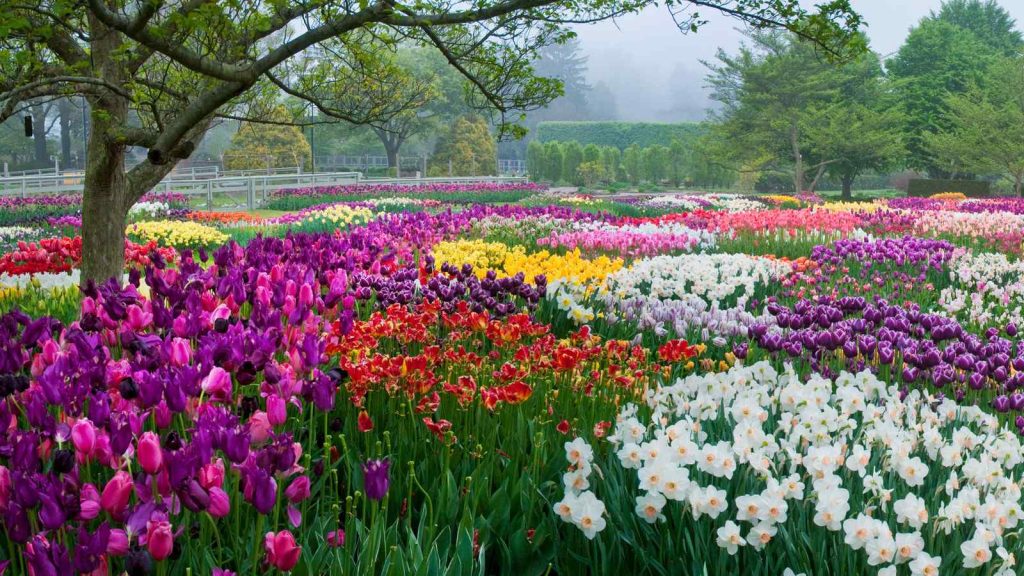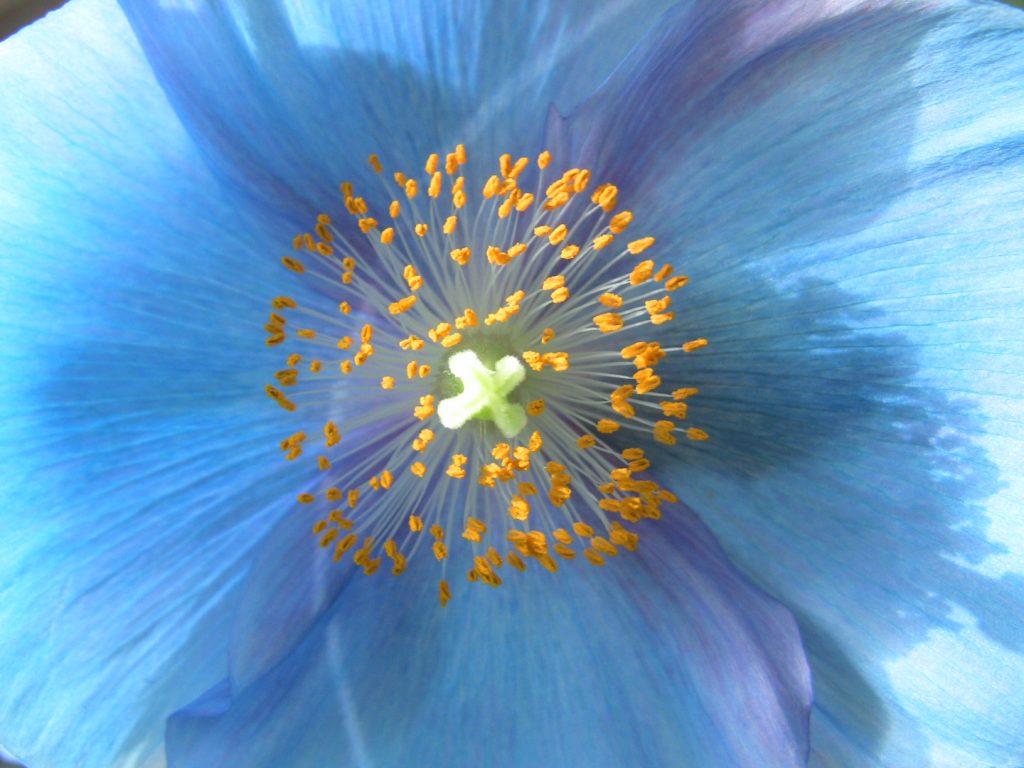Longwood Gardens

My great-grandfather wore a fedora and a pinstripe suit. My great-grandmother wore a floral print dress, a fur stole, and a black hat decorated with white loops of ribbon that looked like macaroni. They stood in front of a circular fountain bordered by fields of tulips. Behind them were brick walls, more fountains, and a row of trees. “Our relatives back in Italy probably thought this is where we lived,” my Aunt Mary chuckled as she handed me the photo, which was obviously not taken in my great- grandparents’ tiny backyard. “What is this place?” I asked. “Longwood Gardens,” she told me, “down near Delaware. It was owned by the DuPonts, a really rich family from Wilmington. It’s open to the public now. Mom & Pop used to take us there every Easter.” I scrutinized the photo, absorbing every detail before announcing: “I’m gonna go there someday.”
My fascination with Longwood Gardens started with that old family photo when I was just a little girl and it hasn’t ended yet. I’ve visited Longwood Gardens countless times with family and friends or alone with sketchpad in hand. And not unlike a love affair, every time I enter that familiar terrain, I exit with a new discovery.
Turns out good old Aunt Mary was right. Longwood Gardens started out as the weekend residence of the DuPont family from 1906 until 1954. Pierre S. DuPont originally bought what used to the be the Peirce family homestead in order to save the adjacent old-growth forest (known as Peirce’s Park) from being chopped down by lumberjacks. But it didn’t take long for P.S. DuPont to recognize the property’s potential, and it became his lifelong labor of love. By 1914, he had laid out the 600-foot-long Flower Garden Walk, begun hosting his famous June garden parties, and installed the Italian-inspired Open Air Theatre, thereby starting Longwood’s tradition of live music and dance performance that continue to this day. P.S. DuPont fed his passion for horticulture by first expanding the courtyard of his home (the Peirce-DuPont House), into a conservatory[1], and eventually building the elegant Conservatory that opened in 1921 and still functions as the crown jewel of the estate. Apparently, it was P.S. DuPont’s childhood dream to build a greenhouse that is open to the public.[2] Not only has his dream been realized on a grand scale, but the Longwood Gardens of today is so much more than a big greenhouse filled with exotic plants. Renowned for its excellence in horticultural research and development, Longwood hybrids such as the Victoria water-platter[3] are sought after by collectors worldwide. Longwood Gardens is also an ecosystem consisting of a vast arboretum, two lakes, a waterfall, and a meadow, all of which provides valuable habitat for many native species and serves as a stage for wildlife conservation and land stewardship efforts, often in conjunction with local universities. The bluebird houses in the meadow are a prime example.[4] Furthermore, Longwood Gardens is an educational institution in its own right, offering courses for professional horticulturalists, programs for K-12 students or college interns, and continuing education classes for professionals and hobbyists in a wide variety of fields, such as floral design, horticulture & gardening, landscape design, and creative arts.[5]
But most visitors are totally unaware of everything going on behind the scenes at Longwood Gardens. They’re coming to see the show. And what a phenomenal show it is!
It’s easy to understand why my great-grandparents ritually took the family to Longwood Gardens at Easter time because this is when the verdant landscape of Southeastern Pennsylvania really springs to life. If you visit Longwood during the Spring Bloomsseason that lasts from the last week of March through the first week of May, it’s like a Hollywood red carpet parade of over 245,000 bulbs! Early in the season, you’ll be greeted by glory-of-the-snow, winter-aconite, and crocus. . . the golden narcissus is next to arrive. . . and finally (trumpet fanfare) . . . the tulips . . . row after row of candy-colored tulips cover the Idea Garden grounds, in adjacent squares evocative of a Mondrian painting. Their glorious cups bobble slightly when their stems wave in the wind, creating a breathtaking ripple effect. When standing amidst their splendor, you can totally get whytulip mania wreaked so much havoc on the Dutch economy in the mid-1600s.[6]
The abundance of graceful flowering trees such as Japanese Cherry (early in the season) and Dogwood (in the middle of the season) is another reason why so many visitors flock to Longwood Gardens for Spring Blooms, but I wouldn't want you to think Spring is the only time to go! Like Vivaldi’s famous concerti, all four seasons at Longwood Gardens offer something spectacular.
The Summer months at Longwood are known as the Festival of Fountains. Inspired by his trips to Italy, Mr. DuPont had several elaborate fountain gardens constructed on the grounds, all of which have been lovingly maintained in accordance with his vision. The star attraction is the recently renovated Main Fountain Garden.[7] Every day, at multiple scheduled times, 175-foot tall plumes and 1,719 swirling jets of water dance to the rhythm of the music. In the evening (Thursday through Saturday), you’ll be treated to a gorgeous multi-colored illuminated performance. As if that weren’t enough, staggered throughout the season, there are 6 shows combining the dancing musical fountain display with fireworks![8]
Now, I’ll clue you in to the less obvious but no less beautiful fountains you should check out if you visit during the Festival of Fountains. The Italian Water Garden, built in 1927, with its terraced slopes and sparkling water reminiscent of diamonds, is one of the most romantic spots on the property.[9] The bench under the shade of the tree is the perfect spot for kissing. (Or meditating upon the meaning of life. Or applying mosquito repellent. Whatever strikes your fancy). If you’re happily hiking through Peirce’s Park, head Eastward down the path to the Sylvan Fountain, an idyllic woodland oasis tucked away in a grove of bottlebrush buckeye (Aesculus parviflora). If you’re puttering around in the Conservatory, take a moment to play in the Children’s Garden fountains, where even grown-ups are allowed to splash around and get wet. Go ahead and stick your head under the rain curtain; it's so refreshing!
The highlight of Autumn’s Colorsat Longwood Gardens is the Chrysanthemum Festival, the largest display of exhibition chrysanthemums in the U.S. In the Conservatory, you’ll be amazed at the sight of over 17,000 chrysanthemums that Longwood’s expert horticulturists have painstakingly nurtured and trained into all kinds of crazy shapes such as spirals, shields, columns, orbs, and pagodas. Taking center stage is thejaw-dropping “Thousand Bloom Chrysanthemum,” a horticultural marvel measuring nearly 12 feet wide and taking 2 years to grow, created by cultivating a singlechrysanthemum plant to produce 1,000 or more uniform evenly spaced blooms according to an ancient Japanese method known as Ozukuri.
There are precious few growers in the world skilled at the technique of training a Thousand Bloom mum, whereby a team of trainers must meticulously pinch and tie the chrysanthemum plant to a wire frame designed by an architect that can be adjusted as the plant grows. Then, they must arrange the blooms into a dome shape and train the plant to achieve as many blooms as humanly possible. Longwood’s team is led by Yoko Arakawa, who travels frequently to Japan to train with master chrysanthemum growers.[10]
In homage to Japanese culture and aesthetics, every Autumn, the entranceways and hallways of the Conservatory are festooned with brightly-colored paper lanterns and this year in the Ballroom (on October 26th& 27th) there will be special displays and demonstrations of Ikebana and Bonsai, which are not just ancient Japanese art forms but also Zen Buddhist spiritual practices.[11]
While the Chrysanthemum Festival is nothing short of a miracle that looks like something only the Oompa-Loompas could have created, you cannot fully appreciate Autumn’s Colors without putting on your down vest and stepping outside to view nature’s great masterpieces: the reflections of the towering trees in the 2 spring-fed lakes that once served as jumping-off points for Pierre S. DuPont’s boating parties and the wide expanse of the grassy meadow ringed in fiery red, orange, and goldforest, the perfect spot for plein airpainting or sketching.
Unless you’re a local who’s grown accustomed to maddening traffic congestion due to the throngs of visitors coming to and from “A Longwood Christmas,” you might be surprised to learn that Winter is by far the most popular season to visit Longwood Gardens. After strolling the grounds, where over 500,000 twinkling lights magically transform the grounds into a Winter Wonderland, you can warm up with a cup of hot cocoa at the terrace café while listening to the joyful sounds of carolers at the entrance. You’ll find the Conservatory packed from floor to ceiling with evergreen trees and wreaths creatively decorated in accordance with a single theme, such as birds, ice, or France, just to name a few. After playing the guess-the-theme game, you can sing along to the sounds of the season at a Longwood Organ holiday concert.[12]
While it’s easy to see how A Longwood Christmas has become a beloved tradition for many regional families and a “must do” on the bucket lists of visitors from around the globe, the Orchid Extravaganza in late Winter (Jan. through March) attracts serious horticulturalists, photographers,and plant lovers alike. Admittedly, we have made it our tradition to visit Longwood every year during the Orchid Extravaganza when outdoor temperatures are still too cold for trees to bud and bulbs to emerge from the earth, but the heated 4-acre Conservatory is teeming with life and bursting with color. It looks like the Oompa-Loompas were hard at work again!
Nearly 5,000 blooming orchids of many varieties (including Phalaenopsis, Cymbidium, Cattleya, Dendrobium, and Paphiopedilum) are amassed into giant hanging orbs, massive panels, and cascading curtains. Orchids drip down from ceilings, cover walls, encircle benches, and spring forth from containers, creating that feeling that you are enveloped by them. Longwood’s talented team of growers intersperses other stunning flowering plant species into the display to add richness and depth; enormous lilies and vibrant anemones are staff favorites (and ours). If you visit in early March, don’t miss the rare Himalayan blue poppies (Meconopsis ‘Lingholm’) that Longwood’s gardeners force to bloom using an artful technique. But beware these flowers are so alluring that they act as a magnet for humans! Don’t be surprised if you find yourself fixated to the point where you have trouble pulling yourself away. You won’t be the first person whose phone runs out of juice because you can’t stop taking pictures of the blue poppies, trust me; it happened to me and my friend.
Now, for some visiting tips geared to specific audiences. First, for children of all ages and the kids in all of us, don’t miss the Children’s Garden in the Conservatory; it’s whimsical animal sculptures and delightful water features provide an oasis of enchantment that’s open year-round. You’ll also want to check out the Garden Railway (open during Autumn’s Colors and A Longwood Christmas). Another fun game to play is to ask for a Gardens Map when you get your ticket for admission, and then once you’re inside, see if you can find the 3 treehouses on the grounds (1 of them is easy to find, but the other 2 are hidden in the woods). The topiary garden is fun too; the bushes are trimmed into cool animal shapes, like Alice in Wonderland.
And now, for the adults. You can’t find a more picturesque and tranquil setting to soak up a live music or dance performance. While some concerts (such as the Longwood organ) can take place during the Fall and Winter months, most of the action happens during the Summer Performance Series, where rising stars or established artists take the stage in the Open Air Theatre. This year’s lineup features Leslie Odom, Jr. of Hamilton fame, Roseanne Cash, and BalletX. The annualWine & Jazz Festival, a 2-day event that occurs the 1st weekend in June, is also immensely popular. Tickets for these summertime events sell out super quick, so be sure to make your reservations well in advance.
For all the craft beer aficionados, Longwood boasts a beer garden that will make you wriggle in your lederhosen. If you’re feeling traditional, you can sip on a signature draft brew designed especially for Longwood by local favorite Victory Brewing Co. while munching on a Bavarian soft pretzel, but if you’re in need of something meatier, you can choose from a selection of pizzas, burgers, sandwiches, and bratwurst (of course). All the while, you can stargaze while listening to excellent live music ranging from roots rock to gypsy jazz to progressive bluegrass to Caribbean steel drums. And if you’re not into the whole beer thing, you can buy French wine for $9 a glass. What’s not to like? Note that the beer garden is only open, weather permitting, on Thursday through Saturday nights from 5:00 to 9:00 pm (May 9th – Aug. 31st) and from 4:00 pm to 8:00 pm (Sept. 5th – Oct. 26th).
Last but definitely not least, for those explorers among you (like me) who enjoy wandering far from the madding crowds, ask for a Gardens Map when you purchase your admissions ticket, and go to the Chimes Tower, the Grotto, and the “big loop” trail bordering the outer edges of the Meadow Garden. In these serene, seemingly private spaces, you can pause for a moment of gratitude or prayer, or just simply reflect on the boundless beauty of nature.
[1] All you history buffs, be sure to visit the Peirce-DuPont house, which has been converted into a charming museum featuring a film and walk-through exhibits on the life of Pierre S. DuPont and the creation of Longwood Gardens. The original courtyard conservatory, which is home to some fabulous old plants and fat lazy cats, has been lovingly preserved and maintained. https://longwoodgardens.org/gardens/peirce-du-pont-house
[2]For more information on the grand Conservatory, see https://longwoodgardens.org/history/1916-1926
[3]For a behind-the-scenes look, including videos, of the debut of the Victoria ‘Longwood hybrid’ water-platter at the Philadelphia Flower Show in 2010, see https://longwoodgardens.org/blog/2010/02/03/longwood-water-platter-ready-for-flower-show-debut
[4]For more about Longwood’s bluebird program, seehttps://plantexplorer.longwoodgardens.org/weboi/oecgi2.exe/INET_ECM_DispTour?TOURCODE=BLUEBIRD
[5]For more on the plethora of Longwood’s educational offerings https://longwoodgardens.org/education
[6]The Dutch Tulip Market Bubble, aka “tulip mania,” during the Dutch Golden Age, was one of the most famous market booms and busts of all time. At the height of the craze, the rarest tulip bulbs traded for as much as 6 times the average person’s annual salary. For more details,see https://www.investopedia.com/terms/d/dutch_tulip_bulb_market_bubble.asp
[7] Tolearn more about the $90 million Main Fountain Garden renovation project, visit the Historic Pump Room & Gallery at Longwood Gardens or see https://www.pennlive.com/gardening/2017/03/fire_on_water_longwood_gardens.html
[8] Bearin mind that the daytime and evening fountain displays are included in the cost of Garden Admission, but the Fireworks & Fountains shows require an extraticket. Due to their popularity, advanced reservations are highly recommended. Don’t forget to bring your own chairs and/or blankets and start packing up your stuff before the finale or it could be Christmas by the time you leave theparking lot. If crowds and kids aren’t your thing, just forget about it and watch the video; you can thank us later.
[9] The layout of the Italian Water Garden is remarkably similar to the one the DuPonts saw at the Villa Gamberaia near Florence. Pierre S. DuPont planned every detail of its design from the sculptures to the hydraulic calculations.
[10]For more about the Chrysanthemum Festival, including a time-lapse video of the creation of the Thousand Bloom mum, seehttps://longwoodgardens.org/events-and-performances/events/chrysanthemum-festival.
[11]For the NYT perspective on The Rise of Modern Ikebana, see https://www.nytimes.com/2017/11/06/t-magazine/ikebana-japanese-flower-art.htmland for an interesting take on why people treat their Bonsai trees like children, see https://qz.com/quartzy/1550988/theres-a-good-reason-bonsai-growers-think-of-trees-as-their-children/
[12] Composed of 10,010 pipes divided into 146 ranks, The Longwood Organ is the largest Aeolian organ ever constructed in a residential setting. Pierre S. du Pont had it custom-designed in 1930, and it remains in Longwood’s Conservatory, where each year the best and brightest young organists compete for prizes before a panel of esteemed judges in an International Organ Competition. The top prizewinner takes home the Pierre S. duPont First Prize of $40,000, the biggest cash prize of any organ competition in the world. For information about the 2019 competitors, see https://longwoodgardens.org/international-organ-competition/2019-competition/competitors

